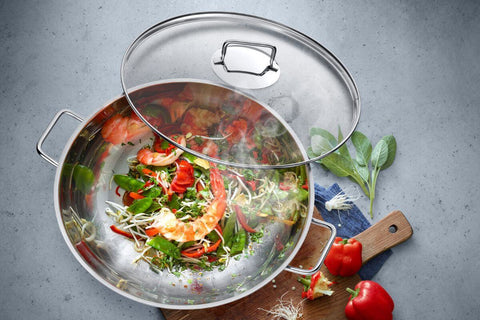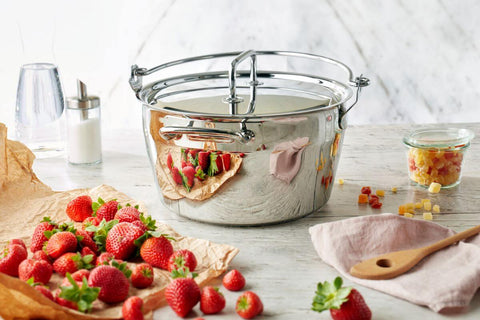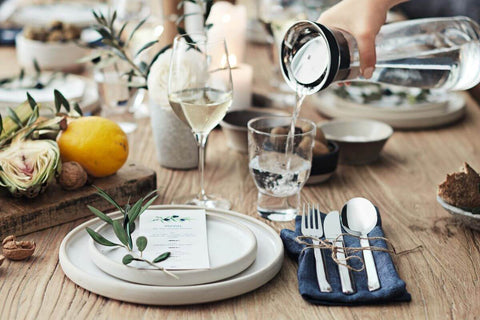Milly's 101: How to Clean Stainless Steel

How do you keep that 'showroom shine' on your stainless steel cookware ensuring it looks good for many years to come? Here's our best advice.
Fresh out of the box? Step one, remove any labels, stickers and packaging then giving it a good wash in hot soapy water that's had 1/4cup of white vinegar added - this will remove any traces of label 'stickiness', manufacturing oils and cleaners. Rinse and dry thoroughly then store carefully.
Then it's all about up-keep, here are our top tips;
1. Water spots: just like with your splash back, glasses and shower, water spots leave marks - there's just no way around it. The trick is to avoid them by dealing with them immediately. After washing, dry your cookware using an absorbent tea towel (you can see our Kitchen Linen picks here).
Too late? When spots have already appeared, simply dampen the surface and rub with a moist sponge that's been sprinkled with baking soda, then rinse well and dry as above.
2. Avoid adding salt to cooking water until it has come to the boil. When water is salted pre-boil "pitting corrosion" can occur which leaves tiny but irreparable pockmarks and pits on the inner surface of your pot. So yes, salt your pasta/ vegetable water but only once it's boiling.
3. Take the chill off refrigerated food before adding it to a pan. Cold food is more likely to stick to a hot pan, as the steel will contract when it comes in contact with a cooler temperature. So, if you're cooking foods like meat, chicken, or fish straight from the fridge, allow them to sit at room temperature for 15 minutes to an hour (depending on what it is - be careful of chicken and fish in warmer temperatures). Before cooking, make sure to dry the surface of what you're cooking with a cloth or paper towel to remove excess moisture - this is especially true for chicken which often 'sticks' due to its high water content.
4. Don't rush the preheating process. All the high-quality stainless steel cookware we offer here at Milly's is effective at holding and distributing the heat, so it would be very rare that you would ever need to use a high heat setting. We recommend you experiment with your pan by heating it gently from low medium to medium high to see how it performs (especially on induction) before you consider taking it to high heats. Modern cookware is much more efficient than the pans of yesteryear and almost invariably doesn't need to be 'seething' to produce the perfect sear and cook. FYI, high heats can lead to overheating resulting in warping, surface discolouration and a really burned dinner!
5. Give your pan a little time and a little heat before you add your oil or butter (or a combo of these), only adding your food once the fat is hot. How can you tell if your pan is hot enough? Take some time to observe your oil - it should shimmer slightly but once it gets to smoking it's too hot so go for that sweet spot around the 'shimmer' mark. Similarly, once it stops frothing and goes 'quiet' it's at the perfect temp for cooking. And always use an oil with an appropriate 'smoke point' for what you're cooking, see our 'What's a Smoke Point' for more info on this.
6. Allow cookware to cool completely before washing. Submerging or soaking any hot pan (or baker/cake tin etc) in cold water can cause warping and surface delamination in both stainless steel and cast iron cookware which is irreparable. Actually, non-stick surfaces don't love it either!
7. Use only non-abrasive cleaners and sponges and always use silicone, wooden or nylon utensils. Coarse scrubbers, steel wool, sharp utensils and harsh cleaning solutions like bleach or other household abrasives (like Jif) can scratch your stainless steel and damage the finish both inside and out, leading to more sticking and difficult to clean areas and scratched mirror finished exteriors. And although baking soda and more abrasive scrubbers (like scourers) can be useful in quickly cleaning a burnished pan, beware that using these products can lead to more problems with your next 'cook'.
For particularly stubborn marks boil some water with a little dishwashing powder to break down the burnt food and work at it slowly with a nylon brush.
8. Stick to a routine. Clean your stainless steel, utensils/cutlery and cookware after each use (even if they don't get very dirty) to avoid a buildup.
9. Polish your stainless steel semi-regularly with a good quality stainless steel cleaner. Many of the cookware brands we stock make their own proprietary cleaners which they recommend specifically for polishing and maintaining their cookware. Demeyere, Le Creuset and WMF specifically for Cromargan (their signature S/S formula).
When something's not quite right?
For cleaning chalky white spots (which can result from calcium buildup in the water): bring a solution of vinegar and water (think 1:3) to a boil in the pan, let it cool, and then wash and dry as normal.
For general buildup: Fill the pan with hot soapy water, and let sit a few hours, before scrubbing with a non-abrasive sponge/nylon brush.
For stuck-on food bits (which can result from adding cold food to a hot pan—see above): scrub the pot with a non-abrasive sponge to get off any food bits you can, then fill the pot or pan with enough soapy water to cover the food, bring to a boil, and scrape (the food should come away easily). You can also do this by replacing soap with a couple of spoons of baking soda or dishwashing powder. Bring it to boil (but watch closely, as it will bubble up), and then reduce it to a simmer. Using a wooden spoon, scrape off the bits of food, which should come off pretty easily. Once you're satisfied with the result, turn it off and let it cool (but don't let it get totally cold). Take it to the sink and use a long-handled brush or gentle scouring pad to scrub the surface clean (don't forget to dry immediately!).
For discoloration (often rainbow in appearance), which can occur from mild overheating: fret not, for a solution is well in sight. Here's what you do: splash a little white vinegar diluted with water into your pan, swirl the mixture around, and use a non-abrasive sponge to wipe away the rainbow stains. Vinegar's acidity will help break down that thin oxidized rainbow layer while still being gentle on your pans. (Alternatively, a sprinkle of Barkeeper's Friend which is similarly acidic yet non-corrosive, will also do the trick.) Rinse, dry, and ... voila!
For hard-to-clean burnt or burnished pans:
If you don't have BKF: Fill the bottom of the pan with water, then add 1 cup of vinegar and bring to a boil. Remove from the heat and add 2 tablespoons of baking soda (beware that this might void your warranty!). Empty the pan and scrub (with a nylon brush or non-abrasive sponge). For stubborn spots that still won't budge, you can make a paste of baking soda and water and leave it applied to the problem areas for a few minutes and then scrub and rinse off.
A few quick tips to keep your Stainless Steel cutlery flawless:
1. Rinse your cutlery after use to remove most food, don't leave it for a long time before washing and drying (cutlery should not be left to soak either, like you might cookware or ovenware).
2. If using a dishwasher, place them in the basket handles down (put different shapes together rather than sorting like with like). Keep your dishwasher running in optimum condition and clean regularly with softening salt.
3. Cutlery does not respond well to high-humidity or being left wet, empty your dishwasher when it's finished and/ or open to door to release the steam when the cycle's finished. If your cutlery's still wet when putting away dry by hand.
Special mention: Table knives and the dishwasher. Your table and entree knives become magnetic when in the dishwasher and will 'attract' rust from other metals (particularly vegetable peelers or can-openers with a lower grade steel content in the blades). The 'rust' needs to be cleaned away with a quick polish using the appropriate cleaner, WMF's Cromargan Cleaner is recommended for WMF cutlery.
- Tags: use-and-care
← Older Post Newer Post →







